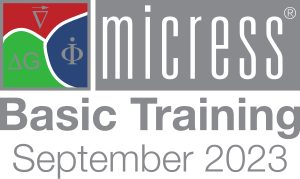
The MICRESS® team has the pleasure to announce an upcoming MICRESS® training. The goal of the tutorial is to help students and researchers from the field of computational materials science to get started with microstructure simulations. Training participants will be introduced by experts in the field to the use of MICRESS® in order to gain hands-on experience that can directly be applied to their own research. The training will be held online. All lectures will be held via WebEx Training, giving participants the ability to configure and run their own MICRESS® simulation during multiple practical exercises. Therefore, there will be no need to have an own MICRESS® installation or license file.
Scientists from both academia and industry are encouraged to register for the training. Participation in the event is free of charge. The number of participants is limited to 30 per group. Please limit registration to a maximum of two participants per institution.
System requirements: A standard browser is sufficient to login to the sessions and follow the presentations. But a Windows system and joining the training with the WebEx App is necessary to participate to the hands-on sessions. During login portable versions of the WebEx Meeting app and WebEx AnyConnect client will be installed.
| Group | Time | |
|---|---|---|
| Group A | Sep 4th and 5th, 2023 from 3 pm to 10 pm (UTC+2)
(recommended for participants from America and Europe) Unfortunately, there were not enough registrations. Please register for Group B if possible. | Cancelled |
| Group B | Sep 7th and 8th, 2023 from 9 am to 4 pm (UTC+2)
(recommended for participants from Asia and Europe) | Registration is closed |
Program – Day 1
| Group A | Group B | Topics | |
|---|---|---|---|
| 14:45-15:00 | 08:45-09:00 | Login | |
| 15:00-15:15 | 09:00-09:15 |
1
Welcome
Plenary
– RA
|
|
| 15:15-16:15 | 09:15-10:15 |
2
Introduction
Plenary
– JE
|
|
| 16:15-16:45 | 10:15-10:45 |
3
Overview of the MICRESS user interface - Demo
Plenary
– RA
|
|
| 16:15-16:30 | 10:45-11:00 |
Coffee break
|
|
| 16:30-16:45 | 11:00-11:15 |
4
Welcome to training with hands-on
Plenary
– RA
|
|
| 16:45-17:15 | 11:15-11:45 |
5a
Training infrastructure
Plenary
– LK
|
|
| 17:15-18:00 | 11:45-12:30 |
5b
Getting started with your first MICRESS simulation
Hands on
| |
| 18:00-18:45 | 12:30-13:15 | Lunch / Dinner break | |
| 18:45-19:30 | 13:15-14:00 |
6
Driving file step by step
Plenary
– BB
|
|
| 19:30-20:00 | 14:00-14:30 |
7a
Demo: Modify a driving file
Plenary
– RA
|
|
| 20:00-20:15 | 14:30-14:45 |
7b
Modifying a driving file
Hands on
|
|
| 20:15-20:30 | 14:45-15:00 | Coffee break Q&A | |
| 20:30-21:00 | 15:00-15:30 |
7c
3D simulation
Hands on
|
|
| 21:00-21:15 | 15:30-15:45 |
7d
Demo: Solution for Voronoi tessalation and going 3D
Demo
|
|
| 21:15-21:45 | 15:45-16:15 |
8
Microstructures
Plenary
– RA
|
Program – Day 2
| Group A | Group B | Topics | |
|---|---|---|---|
| 14:45-15:00 | 08:45-09:00 | Login | |
| 15:00-15:30 | 09:00-09:30 |
9a
Grain growth
Plenary
– JE
|
|
| 15:30-16:00 | 09:30-10:00 |
9b
Grain growth conditions and misorientations
Hands on
|
|
| 16:00-16:30 | 10:00-10:30 | 10a Phase transformations Plenary – JE | |
| 16:30-17:00 | 10:30-11:00 |
10b
Adding phases
Hands on
|
|
| 17:00-17:15 | 11:00-11:15 | Coffee break Q&A | |
| 17:15-17:45 | 11:15-11:45 |
11a
Coupling to thermodynamics
Plenary
– BB
|
|
| 17:45-18:30 | 11:45-12:30 |
11b
Coupling to thermodynamics
Hands on
|
|
| 18:30-19:15 | 12:30-13:15 | Lunch / Dinner break | |
| 19:15-19:45 | 13:15-13:45 |
12a
Nucleation
Plenary
– JE
|
|
| 19:45-20:30 | 13:45-14:30 |
12b
Nucleation
Hands on
|
|
| 20:30-20:45 | 14:30-14:45 | Coffee break Q&A | |
| 20:45-21:15 | 14:45-15:15 | 13 Coupling to the process Plenary – BB | |
| 21:15-21:45 | 15:15-15:45 |
Open discussion
Q&A
|
Pre-Training
Please feel encouraged to complete the following pre-training tasks to be best prepared for the training event.
Watch MICRESS Phenomenology Part 1 to get an introduction into thermodynamics.
Watch MICRESS Phenomenology Part 2 to get an introduction into diffusion and kinetics.
Watch MICRESS Phenomenology Part 3 to get an introduction into multi-phase-field modelling.
Watch MICRESS at work to learn about coupling of thermodynamics and phase-field-modelling.
Watch MICRESS Post-Processing Overview to get an overview of common tools for MICRESS post-processing.
Watch DP_MICRESS Post-Processing Basic Introduction to learn about the features and operational use of DP_MICRESS.
Download and install DP_MICRESS.
Download the following MICRESS simulation examples.
Open each of the examples with DP_MICRESS and inspect the corresponding output.